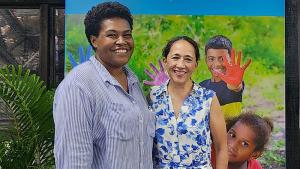International Volunteer Day 2025
We celebrate the impact of Habitat volunteers who work abroad with communities where safe and affordable housing is urgently needed. Happy International Volunteer Day!
MANILA (Dec. 5, 2025) - Every year on December 5, Habitat for Humanity joins the United Nations and organizations worldwide to honor the impact of volunteers. Our volunteers, whether they are serving with their own communities or around the world, play a vital role in Habitat’s mission. Thanks to their dedication, we helped more than 1.2 million people in the Asia-Pacific region build or improve the places they call home in fiscal year 2025.
International volunteers

Leo Perego first began as an international volunteer in 2007. Eighteen years later, each experience of building with local communities brings fresh emotional impact. “It’s not just construction,” he says. “It’s connection. You build alongside people, not for them. That’s what makes it meaningful.”
He recalls a defining moment when he returned to a build site in Bangalore, India, nearly a decade later. A boy that he met was now a university student, still living in the same home Habitat helped build. “Seeing that transformation, from a fragile start to a stable, hopeful future, was incredibly moving,” he says. “It reminded me how lasting and life-changing Habitat’s work truly is.”
Back home, he speaks up for the cause of housing with friends and even strangers. “Without a safe space to live in, people cannot strive. Housing is not just about walls. It’s about dignity, opportunity, and hope.”
To those who hesitate to volunteer, Leo says, “There’s no perfect time to start. Just show up. You’ll see what it means to build something that lasts. You’ll meet people who will change your life, and you’ll help change theirs.

Now in the 14th year of her volunteering journey, Robyn (pictured above, second from left) has built multiple times in Vietnam. “Every build is different but at its heart it is the same,” she says.
Working on a new home with a mother-to-be of twins was a memorable experience. Robyn and her team of volunteers worked hard with the hope that the babies would have a safe place to live and grow up in, and the mother could have the confidence to focus on making a living.
Is volunteering worth the time and the resources? Robyn has no doubt. “Just do it! It will change your life. Your contribution makes a huge positive difference for someone who had little hope before. You are the hope builder.”

Kirk Nelson (pictured above, left) is not new to Habitat for Humanity’s Global Village program having joined 17 international builds. But his first volunteering experience in Fiji felt like a new adventure with a familiar purpose. “I believe in the mission of Habitat and want to continue helping as often as I can. We chose Fiji because Jackie (volunteer team leader) and I had never been there before, and the program sounded very interesting to us.”
The housing need in Fiji is just as great as what Kirk has witnessed in many parts of the world. However, a particular moment stood out for him. “When we met with the Turaga Ni Koro(village head) on Monday, he said something like, ‘You are no longer visitors or volunteers in this community. You are now considered part of the community and a member of the community.’ Through the build week, that was very evident to be true. They treated us like family.”
From learning clever building tricks like using a PVC pipe and nail to start holes in the metal roofing to sharing laughter and meals with new friends, Kirk left Fiji with a piece of the community in his heart.
What they say

“Age is irrelevant. Once you’ve seen the impact, you carry it with you.”
- Bronwyn Peyton, Australia
“Volunteering isn’t just about giving time; it’s about creating hope and shaping futures. Everyone should experience this at least once — it might change your life too.”
— Nickolas (center) with fellow volunteers


“Governments often fund flashy projects to appear responsive. But what people really need is housing. I would love to see more leaders experience a build firsthand. It would change the way they think about what truly matters.”
— Bruce Ibsen, Australia
Get involved
Global Village is a transformative weeklong international volunteer experience with opportunities across five continents including Asia and the Pacific.

Together, we build stronger communities
We celebrate the impact of Habitat volunteers who work abroad with communities where safe and affordable housing is urgently needed. Happy International Volunteer Day!
















